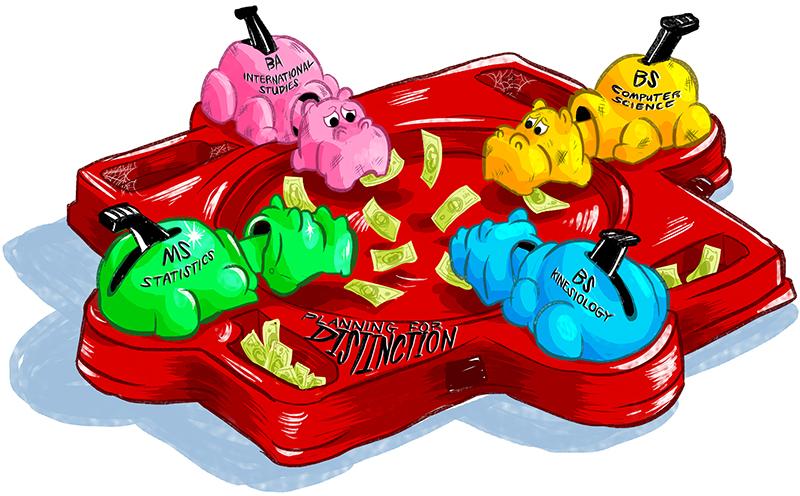New report suggests changes in program funding
Illustration | Brittany England
A new report’s findings recommends the university invest more in some programs and reduce funding to other majors that produce less degrees.
July 10, 2014
A controversial, two-year process of evaluating and ranking academic and support programs in order to determine how to distribute the budget has come to a close and is entering the next phase of implementation.
Provost James Houpis and Chief Financial Officer Brad Wells spearheaded Planning for Distinction at the start of summer 2012.
The Instructional Program Task Group was charged with evaluating academic programs, the Support Program Task Group with evaluating administrative services and the Steering Committee with overseeing the task groups.
A major recommendation for instructional programs was for “the university carefully consider the resource implications of a large number of both undergraduate and graduate majors and options that have a very small number of degrees awarded each year,” according to the IPTG report.
Terry Jones, professor of social work, said his department’s students could not have been successful without “all the things that make up a real university” because “it blends together to create … an educated person,” according to the IPTG campus forum transcript.
Of the 353 academic programs reviewed, 57 were ranked as meriting additional investment, 178 warranted maintained investment, 82 were ranked in the lower 20 percent and 36 programs were ranked in the bottom 10 percent, with the latter 118 programs categorized as needing additional review.
“The report creates kind of a top 10 list,” said Jeff Seitz, professor of earth and environmental sciences, according to the IPTG campus form transcript, “rather than any meaningful narrative about how a program can improve itself with the criteria that had been set in this process.”
According to the IPTG report, five criteria were used to evaluate programs “using the same methodology across all departments and programs”: (1) consistency with East Bay’s shared strategic commitments and institutional learning outcomes (2) internal and external demand (3) program quality (4) costs and productivity and (5) unique issues and future directions.
“The rubric itself is flawed, some of the thinking behind it is flawed,” said Nicholas Baham, professor of ethnic studies, according to the IPTG campus forum transcript, “and the way it was formed in an undemocratic fashion is also flawed.”
Members of the PFD committees that determined the rubric for programs were selected by the administration, bypassing the right of the Academic Senate to elect faculty members onto committees.
“Faculty members need to pick their own representatives on a process like this, which did not happen in this case,” said Jennifer Eagan, professor of philosophy, according to the IPTG campus forum transcript.
The Committee on Resources and Academic Planning is responsible for assessing instructional programs, so the trajectory the academic recommendations will take is unclear, but support services, such as academic advising, will be impacted as early as this summer.
“The president’s cabinet is actively discussing the administrative report because that’s one that doesn’t need any faculty involvement,” said Special Projects Director Lori Erdman, who was hired to manage the project in August 2012, “they can just decide what they’re going to move forward with.”
PFD is a modified version of the model in Robert Dickeson’s book “Prioritizing Academic Programs and Services,” which has been used by several institutions with varying degrees of success.
Hank Reichman, professor of history, wrote a memo that indicated Dickeson is controversial because of his statements about the costliness of faculty and tenure positions, raising questions about whether the values of the Dickeson Model align with those of a university.
















